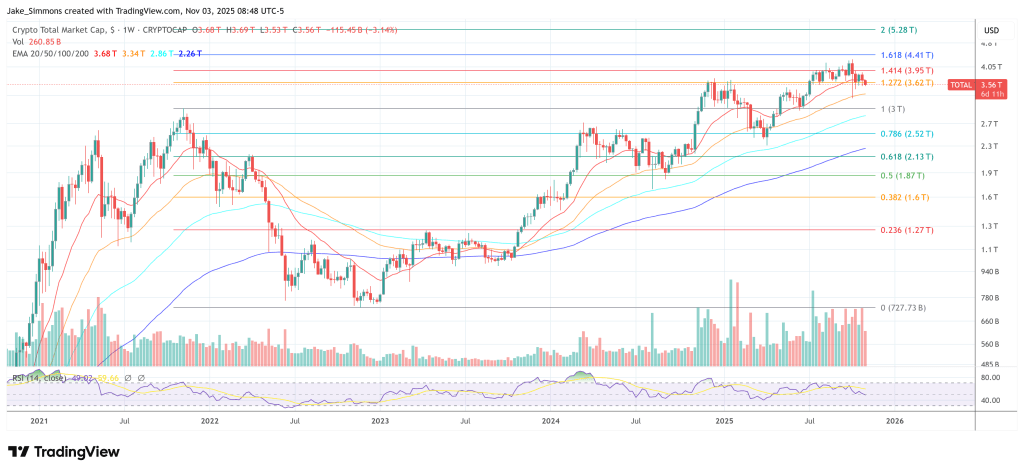On November 2, 2025, crypto analyst Ignas | DeFi distilled crypto’s current standoff into a clean ledger of pros and cons. The Bearish Case For Crypto The first bear pillar is the “AI bubble” overhang. Late-October headlines crystallized the debate as Nvidia briefly breached a $5 trillion market value, a milestone that sharpened concern that equity valuations tied to AI infrastructure spending may be running ahead of realized returns. Point two—“bullish news fail to pump”—was on display as “Uptober” ended with a whimper for the crypto market. Despite intermittent policy tailwinds and strong ETF inflows mid-month, both Bitcoin and Ethereum faded into month-end, and US spot ETF flows turned sharply negative over the final three trading days of October, a pattern consistent with risk aversion after the Oct. 10–11 shock. Related Reading: Is Crypto ‘Boring’ Now? Bitwise CEO Says The Market Is Changing That shock, the “10/10 crash,” is the third bear lever. The two-day downdraft followed a sudden tariff escalation threat from the White House and produced one of the largest one-day liquidations in crypto history, spurring a rush for downside hedges and leaving the market probing for “dead entities” and hidden impairments. Cycle timing is Ignas’ fourth bear note. The fourth Bitcoin halving occurred on April 20, 2024 (block 840,000). Prior cycles do not map one-for-one, but the post-halving window is a pattern which gets a lot of attention at the moment. If the “cycle is not dead,” a Bitcoin top may already be in or is looming by the end of the year. “Old OG wallets selling” is the fifth bear claimant—and, for once, the chain tells a clear story. Since mid-October, long-term holders have materially increased net distribution, with Glassnode and other trackers flagging outflows on the order of tens of thousands of BTC, alongside headline-grabbing awakenings of Satoshi-era wallets. This does not prove panic, but it does inject supply at a delicate moment. Negative ETF flows round out the bear list. Farside’s fund-by-fund ledger shows pronounced outflows on October 29–31 across several US spot Bitcoin ETFs, with total daily net redemptions exceeding $470 million on October 29 and $488 million on October 30, before another hit on October 31 (191 million). While October closed with a inflow total of 3.424 billion, the message: the “fast money” cohort that chased the summer breakout was, at least temporarily, in retreat. Buffett’s caution is the macro bear exclamation point. Berkshire Hathaway’s third-quarter print revealed a record $381.7 billion cash pile and a twelfth straight quarter as a net seller of equities—a posture that telegraphs wariness about broad risk assets and liquidity conditions even as operating earnings rise. For crypto, this is not a direct flow, but it is a bellwether for global risk appetite. The Bull Case For Crypto The bull case, however, is not hand-waving. Start with “liquidity easing & interest cuts.” The ECB has already delivered substantial easing this year and paused; the Bank of England has begun cutting; and in the US, the Federal Reserve is also expected to close out the year with two more cuts while ending quantitative tightening. Related Reading: Powell, The FOMC, And Crypto: The Message Everyone Missed Ignas also says “no clear euphoria,” and—empirically—he’s right. The Crypto Fear & Greed Index spent the past week toggling between “Fear” and low “Neutral,” printing in the mid-30s to low-40s as of November 3. That’s a long way from the 80s–90s “extreme greed” that often sets up blow-off tops, and it supports the idea that positioning is not yet dangerously crowded. Institutional adoption remains the quiet compounding force in the bull ledger. With $30.2 billion year-to-date inflows, spot Bitcoin ETFs are fueling most of the market strength. On policy, the US did more than chatter in 2025: the Senate passed, and President Trump signed, a bipartisan stablecoin law in July. A broader market-structure bill remains in play, but even the stablecoin win is non-trivial for on-chain liquidity and payments rails. Seasonality also favors patience. Since 2013, Q4 has been Bitcoin’s strongest quarter on average, with multiple cycles posting outsized November–December runs. Then there’s the stablecoin plumbing. Despite October’s chaos, aggregate stablecoin float sits around $307–308 billion and notched fresh all-time highs in mid-October—a sign that dry powder inside crypto’s own rails remains abundant and ready to mobilize if confidence stabilizes. As of today, DefiLlama pegs the total at roughly $307.6 billion. Finally, the US–China trade war has seen extremely positive progress. “This is the BIGGEST de-escalation yet. Under the new US-China trade deal, President Trump made a HUGE agreement with China: China will suspend ALL retaliatory tariffs announced since March 4th. And, China will suspend or remove ALL retaliatory non-tariff countermeasures taken since March 4th. This is not getting nearly enough attention,” The Kobeissi Letter wrote via X on Sunday. At press time, the total crypto market cap stood at $3.56 trillion. Featured image created with DALL.E, chart from TradingView.com







